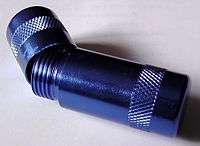Recreational use of nitrous oxide
Recreational use of nitrous oxide is the inhalation of nitrous oxide gas for its euphoriant effects.
Inhalation of nitrous oxide
Nitrous oxide (N2O) is a dissociative inhalant that can cause analgesia, euphoria, dizziness, flanging of sound, and, in some cases, slight hallucinations and mild aphrodisiac effect.
During the 19th century, William James and many contemporaries found that inhalation of nitrous oxide resulted in a powerful spiritual and mystical experience for the user. James claimed to experience the fusing of dichotomies into a unity and a revelation of ultimate truth during the inhalation of nitrous oxide. Memory of this experience, however, quickly faded and any attempt to communicate was difficult at best. James described a man who, when under the influence of the gas, claimed to know the secret of the universe.[1]
The drug currently enjoys moderate popularity in some countries. It was often sold at Grateful Dead and Phish concerts. One slang term for the drug is Hippie Crack; this term implies commentary on the typical user of the substances as well as purported similarities between its psychological addiction potential or the short-lived duration of its effects and similar properties of "crack" cocaine.
Methods of inhalation
Recreational users generally use 8g containers of nitrous oxide "whippets", which they use to fill balloons or whipped cream dispensers. The gas is then inhaled from the balloon or dispenser. This is necessary because nitrous oxide is very cold when it decompresses on exit from a canister; inhalation directly from a tank is dangerous and can cause frostbite of the larynx. Some users attach gas masks or other inhalation devices to large tanks of the gas.
Health concerns
Since nitrous oxide can cause dizziness, dissociation, and temporary loss of motor control, it is unsafe to inhale while standing up. Inhalation directly from a tank poses serious health risks, as it can cause frostbite since the gas is very cold when released. For those reasons, most recreational users will discharge the gas into a balloon or whipped cream dispenser before inhaling.
Nitrous oxide can be habit-forming, mainly because of its short-lived effect (generally from 1–5 minutes in recreational doses) and ease of access. Death can result if it is inhaled in such a way that not enough oxygen is breathed in. While the pure gas is not toxic, long-term use has been associated with vitamin B12 deficiency and its symptoms: anemia due to reduced hemopoiesis, neuropathy, tinnitus, and numbness in extremities. Pregnant women should not use nitrous oxide recreationally, because chronic use is also teratogenic and foetotoxic.
Inhaling industrial-grade nitrous oxide is also dangerous, as it contains many impurities and is not intended for use on humans. Food grade nitrous oxide is also not meant to be inhaled; the bulbs commonly have industrial lubricants from their manufacturing process on and in them. When the bulb is punctured, these solvents can aerosol, introducing unknown particles into the gas. These lubricants commonly leave an oily residue on the bulb "cracker" or inside the whipped cream dispenser.

Legality
Under United States federal law, possession of nitrous oxide is legal and is not subject to DEA purview. It is, however, regulated by the Food and Drug Administration under the Food Drug and Cosmetics Act. Prosecution is possible under its "misbranding" clauses, prohibiting the sale or distribution of nitrous oxide for the purpose of human consumption (the recreational drug use market). Given the necessity of proving intent of either buyer or seller in this case, though, such prosecution are rare.
Many states have laws regulating the possession, sale, and distribution of nitrous oxide; but these are normally limited to either banning distribution to minors, or to setting an upper limit for the amount of nitrous oxide that may be sold without special license, rather than banning possession or distribution completely. In most jurisdictions, like at the federal level, sale or distribution for the purpose of human consumption is illegal. In California, for instance, inhalation of nitrous oxide "for the purpose of causing euphoria, or for the purpose of changing in any manner one’s mental processes," is a criminal offense under its criminal code (Cal. Pen. Code, Sec. 381b). In many other countries, this substance is legal. Small N2O cartridges, used to make whipped cream, are available to buy by anyone.
In all jurisdictions, however, such distribution, possession, and use are legal even though intended for human consumption, when done under the supervision and direction of licensed medical professional such as a physician or dentist.
Recreational use of Nitrous Oxide is illegal in the London Borough of Lambeth since August, 2015, but Nitrous Oxide remains legal in all other areas of the United Kingdom.[2]
See also
References
- ↑ James, William (1882), The Subjective Effects of Nitrous Oxide, retrieved 27 November 2015
- ↑ http://www.bbc.com/news/uk-33955823
External links
- Erowid Nitrous Oxide Vault
- Nitrous Oxide FAQ
- National Pollutant Inventory - Oxides of nitrogen fact sheet
- The Use of Nitrous Oxide in Dentistry

